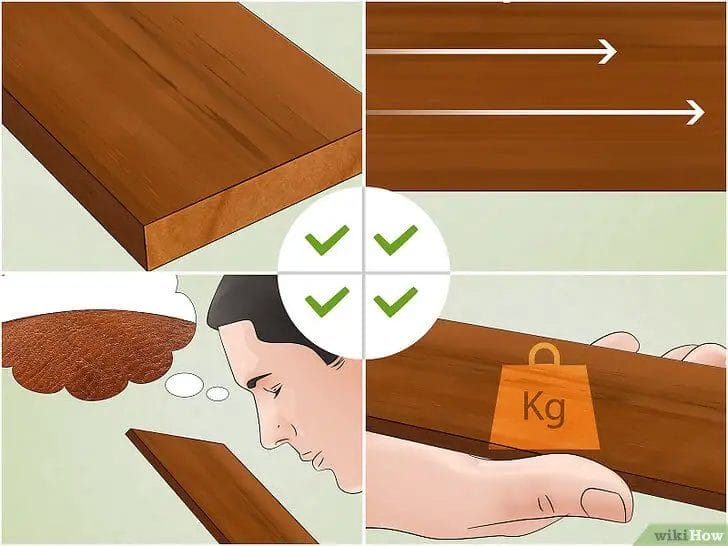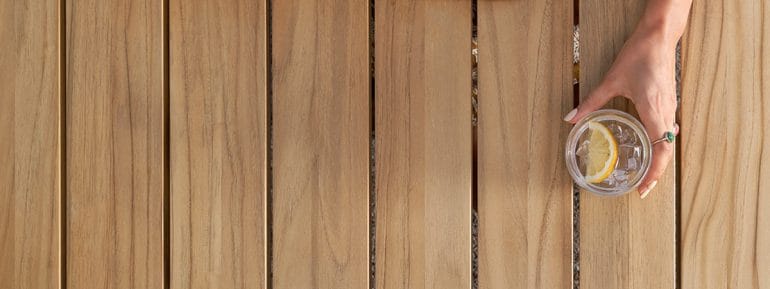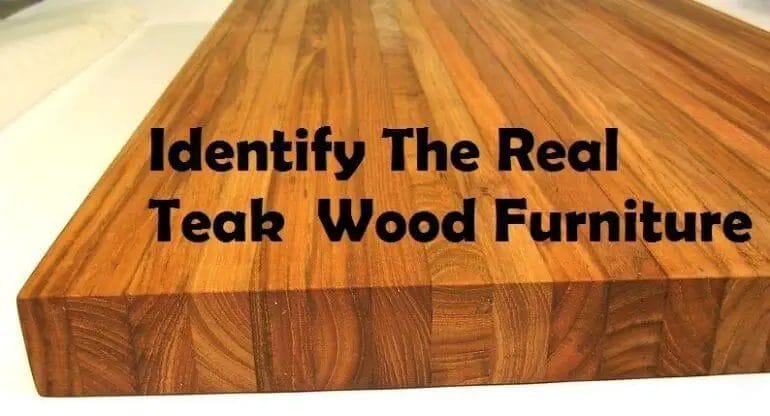Identifying teak wood is crucial for furniture enthusiasts and buyers looking for high-quality, durable pieces. With its unique grain patterns, rich golden hue, and exceptional resistance to decay and pests, teak wood stands out among other hardwoods. One way to identify teak wood is by its distinct scent, often described as a combination of leather and freshly cut wood. Additionally, teak wood has a dense, oily texture that feels smooth to the touch. Its characteristic weight, durability, and ability to withstand extreme weather conditions also make teak wood easily recognizable.

Visual Identification: Spotting Teak Wood Through Grain Patterns
Teak wood is known for its durability, beauty, and resistance to rot and pests. It is a highly sought-after material for furniture, flooring, and outdoor applications. However, identifying teak wood can sometimes be tricky, especially if you don’t have much experience with different wood types. One of the key features that can help you distinguish teak wood is its distinct grain patterns.

Understanding Grain Patterns
Grain patterns in wood refer to the lines and texture that are visible on the surface of the material. Each type of wood has its own unique grain pattern, making it a great tool for identification. Teak wood is no exception and has some distinct characteristics that can help you spot it.
Characteristics of Teak Wood Grain
Teak wood typically has a straight or slightly wavy grain pattern. The lines are usually close together and evenly spaced, giving it a uniform appearance. The grain is often described as being coarse, but with a smooth texture when touched. This combination of straight lines and coarse textures is a good indication that the wood is teak.
Another characteristic of teak wood grain is its golden to medium brown color. When freshly cut, it has a light golden hue that darkens over time to a rich, warm brown. This color change is a natural process and a good indicator of the authenticity of teak wood.
Spotting Teak Wood Through Grain Patterns
When trying to identify teak wood, it is important to closely examine the grain patterns. Here are a few steps to help you spot teak wood:
- Inspect the grain: Look for straight or slightly wavy lines that are evenly spaced. Teak wood grain is generally uniform and consistent.
- Feel the texture: Run your fingers along the surface of the wood. Teak wood should have a coarse texture but feel smooth to the touch.
- Observe the color: Teak wood starts off with a light golden hue and matures into a deep brown over time. Look for these color variations.
- Check for oiliness: Teak wood contains natural oils that help protect it from water damage. If you notice a slight oiliness on the surface, it could be an indication of teak wood.
Remember, grain patterns alone might not be enough to confirm the wood type. It is always recommended to seek professional advice or consult reference materials to ensure accurate identification.
In summary, teak wood can be identified through its distinct grain patterns. Look for straight or slightly wavy lines, uniform texture, color variations from light golden to deep brown, and a slight oiliness on the surface. While grain patterns provide a good starting point, it is essential to consult experts or reference materials for a conclusive identification.

Testing Techniques: Determining Teak Wood with Simple Experiments
Teak wood is a popular choice for furniture and outdoor structures due to its durability and natural beauty. However, it can be challenging to determine if a piece of wood is genuine teak or an imitation. In this section, we will explore some simple experiments that can help you identify teak wood with confidence.
1. Visual Examination
The first step in determining teak wood is to visually examine the wood’s appearance. Genuine teak wood has a unique grain pattern with alternating dark and light lines. The grain is usually straight, but it can have slight waves or curves. Additionally, teak wood has a rich golden-brown color when it is fresh, which gradually matures into a silver-gray patina over time. If the wood you are examining lacks these characteristics, it is likely not teak.
2. Weight Comparison
Teak wood is relatively dense and heavy compared to other types of wood. You can compare the weight of the wood you are testing with a known teak sample to determine if they are similar. However, this method may not be foolproof as the weight can vary depending on factors such as moisture content and processing.
3. Smell Test
Teak wood has a distinctive aroma that is often described as a combination of leather and a sweet, musky scent. To perform the smell test, rub the surface of the wood with your hand or a piece of cloth and inhale deeply. If the wood emits a pleasant smell similar to the description, it is likely teak.
4. Water Resistance Test
One of the most notable characteristics of teak wood is its exceptional water resistance. You can conduct a simple water resistance test by placing a small droplet of water on the surface of the wood and observing how it reacts. Genuine teak wood will repel the water droplet, causing it to bead up and roll off. In contrast, other types of wood may absorb the water or leave a mark.
5. Burn Test
The burn test can be used as a final confirmation to identify teak wood. However, it should be performed with caution and only in a controlled environment. To conduct the burn test, take a small shaving or splinter of the wood and ignite it with a lighter or match. Genuine teak wood will produce a white ash and emit a distinct aromatic scent, similar to the smell test. If the wood produces a different color ash or an unpleasant odor, it is likely not teak.
Summary
In summary, several simple experiments can help determine if a piece of wood is genuine teak. Visual examination, weight comparison, smell test, water resistance test, and burn test are effective methods that can be used individually or in combination. Remember that no single test is foolproof, and it is best to utilize multiple techniques to increase your confidence in identifying teak wood. By employing these testing techniques, you can make informed decisions when purchasing teak wood products.

Comparing Teak Wood with Look-Alike Species: Avoiding Common Mistakes
Teak wood is highly regarded for its durability, natural beauty, and versatility. It is often considered the gold standard for outdoor furniture, boat decking, and flooring. However, due to its popularity, there has been an increase in the availability of look-alike species that claim to offer similar qualities at a lower price. In this section, we will explore the common mistakes people make when comparing teak wood with its substitutes and how to avoid them.
1. Misidentifying the Wood Species
One of the most common mistakes made when comparing teak wood with look-alike species is misidentifying the wood species. Some sellers or manufacturers may label their products as teak wood when they are actually made from other hardwoods or even engineered materials.
To avoid this mistake, it is important to educate yourself about the characteristics of genuine teak wood. Teak wood is known for its golden brown color, straight grain, and smooth texture. It has a high oil content, which makes it resistant to rot, insects, and weathering. Look-alike species may resemble teak wood to some extent, but they often lack its unique qualities.
2. Not Considering the Source
The source of the wood is another crucial factor to consider when comparing teak wood with its substitutes. Teak wood is native to Southeast Asia, particularly countries like Myanmar, Indonesia, and Thailand. These regions have a long-standing tradition of growing and harvesting teak sustainably.
On the other hand, look-alike species may come from less reputable sources where illegal logging and deforestation practices prevail. Buying wood that is not ethically sourced can contribute to environmental degradation and support illegal trade. Therefore, it is important to choose teak wood or its substitutes from certified sources that follow sustainable practices.
3. Ignoring Durability and Longevity
One of the main reasons people choose teak wood for their outdoor furniture or decking is its exceptional durability and longevity. Genuine teak wood can withstand extreme weather conditions, including heavy rain, direct sunlight, and even saltwater exposure. It requires minimal maintenance and can last for decades, if not generations.
Look-alike species may claim to offer similar durability, but they often fall short in comparison. These substitutes may be more susceptible to rotting, warping, or fading over time. They may also require regular sealing or staining to maintain their appearance and protection. Thus, it is crucial to consider the long-term durability and maintenance requirements when comparing teak wood with look-alike species.
4. Overlooking Price-Quality Ratio
While it is tempting to opt for look-alike species due to their lower price tag, it is important to consider the price-quality ratio. Genuine teak wood may come with a higher upfront cost, but its exceptional quality and durability make it a worthwhile investment in the long run.
Look-alike species may be cheaper initially, but they may require frequent replacements or repairs, leading to higher costs in the long term. Additionally, the aesthetic appeal and value of genuine teak wood are often superior to its substitutes. Therefore, it is essential to evaluate the overall value and quality before making a final decision.
Summary
When comparing teak wood with look-alike species, it is crucial to avoid common mistakes such as misidentifying the wood species, not considering the source, ignoring durability and longevity, and overlooking the price-quality ratio. Genuine teak wood offers unparalleled qualities and sustainability when sourced from reputable suppliers. By understanding these key factors and making an informed decision, you can ensure that you choose the right wood for your needs and avoid any disappointments in the future.
Expert Tips: Seek Professional Advice to Accurately Identify Teak Wood
Teak wood is a highly sought-after timber due to its durability, strength, and beautiful grain patterns. However, identifying teak wood can be challenging, especially for those without experience in woodworking or timber identification. To ensure you are getting genuine teak wood, it is advisable to seek professional advice. Here are some expert tips to help you accurately identify teak wood:
1. Consult a Woodworking Expert:
If you are unsure about the authenticity of the teak wood, it is best to consult a woodworking expert or a professional in timber identification. They have the knowledge and experience to differentiate teak wood from other wood species.
2. Examine the Wood Grain:
Teak wood is known for its distinct grain patterns, which are often straight or slightly wavy. The grain is usually coarse, giving the wood a unique texture. Look for these characteristics when examining the wood to determine if it is teak.
3. Check for Golden Brown Color:
Teak wood typically has a warm golden brown color, which may vary slightly depending on the age and exposure to sunlight. Be cautious of wood that appears too red or too dark, as it may not be genuine teak.
4. Assess the Weight of the Wood:
Teak wood is known for its density and heaviness. If the wood feels significantly heavier than other types of wood, it could be an indication that it is teak. However, this method alone may not be conclusive, as some other hardwoods can also be heavy.
5. Smell the Wood:
Teak wood has a unique and pleasant aroma, often described as a mix of leather and rosewood. Gently rub or scratch the wood surface to release its scent. If the wood emits a distinct fragrance, it is more likely to be teak.
6. Look for Oil Content:
Teak wood naturally contains oils that help protect it from moisture and insects. These oils give teak wood its characteristic durability. If you notice a slightly oily or greasy feel when touching the wood, it could be a sign that it is teak.
7. Seek Documentation:
If you are purchasing teak wood from a reputable source or dealer, it is advisable to ask for documentation that certifies the authenticity of the wood. This could include certificates of origin or proof of sustainable sourcing.
8. Compare with Known Samples:
If you have access to known samples of teak wood, compare them with the wood in question. Look for similarities in color, grain patterns, texture, and weight. This comparative analysis can provide a better understanding of whether the wood is teak or not.
By following these expert tips and seeking professional advice, you can accurately identify teak wood and avoid purchasing counterfeit or inferior quality wood. Remember, it is always worth investing in genuine teak wood for its timeless beauty and long-lasting durability.
Frequently Asked Questions
How can I identify teak wood?
To identify teak wood, look for the following characteristics: a golden brown color, straight grains, a smooth texture, and a distinct oily feel. Teak wood is also highly resistant to moisture, insects, and decay, making it a popular choice for furniture and outdoor applications.
Conclusion
In conclusion, identifying teak wood requires a careful examination of its physical characteristics and durability. The rich golden-brown color, distinct grain patterns, and smooth texture are key indicators of authentic teak. Additionally, teak wood is known for its exceptional strength, resistance to decay, and minimal warping or cracking. Its high oil content also contributes to its natural weather resistance and durability, making it a popular choice for outdoor furniture and boat building. By considering these features and consulting experts or reputable sources, you can confidently identify genuine teak wood for your needs.